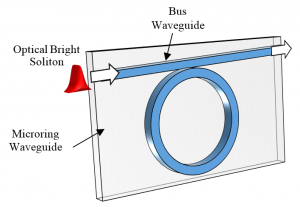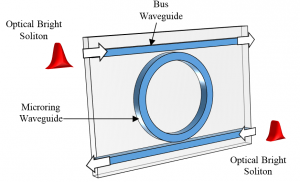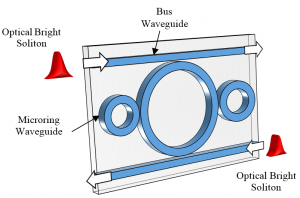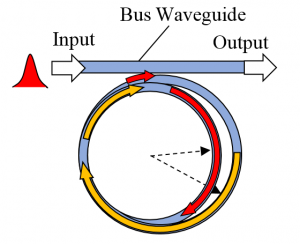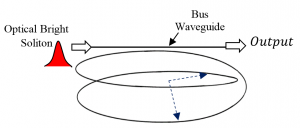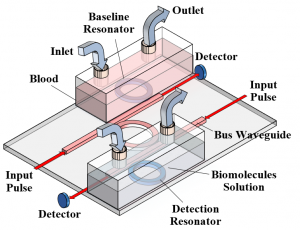In integrated photonics technology, microring resonator is known as an important component that has capability on performing various all-optical applications such as optical filter, lasing, optical memory, and optical switching. Microring resonator able enhance the nonlinear properties of an optical system such as optical bistability, bifurcation and chaos with low input power consumption, small volume and high resonance. This research is performed in theoretical and simulation which provides a versatile pathway for the analysis of fundamental linear and nonlinear response in optical waveguide system. The investigation of the nonlinear optics phenomena of optical resonator waveguide is not just contribute in optics but reaching other research field such as biomedical, sensor, and communications. In Laser center, the key research areas under Microring Resonators Group are optical sensing, switching, storage and communication. The modelling (of various the optical fields such as sinusoidal continuous wave, Gaussian, soliton pulse), Numerical Analysis and theoretical simulation by MATLAB and OPTIWAVE software are performed to compute and analyze the mathematical formulation and the signal properties of optical field propagation within the optical resonator system. Microring Resonator research group manages wide fields of physics: The mathematical modelling using iterative programming script for investigating the nonlinear behavior of the output signal. The transfer matrix analysis, signal flow graph, split step-step analysis and coupled mode theory provide the optical transfer function for analyzing optical fields of resonator system. We develop several configuration of microring resonator system to provide the enhancement of optical nonlinear effect listed as follows: All-pass Microring resonator
All-pass Mobius microring resonator system The analytical treatment of optical signal processing for the optical communication based on the iterative modelling for microring resonator operation. The use of the concept of cryptography and steganography to design the optical information security devices. The optical switching operation in range of mill-watt for the nonlinear medium using optical bistability. The theoretical modelling of optical bistability operation to demonstrate the switching operation. The design of microring resonator system for the detection of biomolecules. The sensor operation is piloted in a basis of Total Internal Reflection and coupled-mode principle. The output data of the optical loss, resonance and spectrum of light matter interaction is presented. Recently, the research on the salmonella bacterium detection is performed by applying three microring waveguide as a baseline, detection unit and signal amplifier in the optical microresonator system as illustrated bellow
The collaborative work with the Faculty of Biomedical Enginnering of Bioinformatics Research Group, Universiti Teknologi Malaysia (UTM) has been made for the validation of theoretical modelling regarding to the interaction of biomolecules with the surface of the optical waveguide. The optimization of the sensing system is conducted by applying the flagellin layer towards the microring resonator system with applied perturbation effect of system nonlinear index. Schematics Diagram of Salmonella bacterium detection using optical microring resonator The analysis of the gradient force and scattering force experienced by nanoparticles. The interaction of nanoparticle with the generated optical trapping pulse is studied. This research focuses on the design and development of optical ring resonator system for generation of optical tweezers pulses for particle trapping purposes. Dynamical behavior of potential well are studied and the corresponding optical forces components acting on the trapped particle are measured by using Rayleigh’s dipole approximation theory. The investigation temperature sensor using all-pass resonator configuration using the split-step Fourier method. The detection output based on the change of signal peak amplitude fit and wavelength shift. The reduction ratio of output intensity is observed with increasing temperature based on thermo-optics effect. The investigation of microring resonator design is performed to provide the enhancement of the heat sensitivity. Besides, the members are encouraged to involve in various activities such as organizing a seminars, presenting seminar and conferences in local and international level which sponsor by the Laser Center Grantt. This research group also having collaboration with King’s Mongkut Institute of Technology, Landkrabang Thailand.

